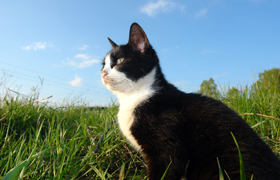Cat owners required for uni research
Release Date 08 August 2012

Researchers at the University of Reading are looking for volunteers in the area to take part in a series of studies, to find out whether domestic cats are having an impact on bird numbers.
Dr Phil Baker from the University's School of Biological Sciences is leading the studies. He said: "There has recently been a lot of discussion about the possible impact that domestic cats may be having on urban bird populations, leading some well-known TV presenters to call for an increase in the number of cats that are fitted with bells and which are kept in at night.
"However, there is limited data to suggest whether cats are actually having an impact, so through this research we are aiming to produce a more detailed picture of cats' behaviour. We need volunteers with cats who don't bring home prey as well as those that do, as we can use hair samples from the cats to investigate whether relying on prey returned home is useful or not."
There are three separate cat studies taking place, and Dr Baker needs feline volunteers and their owners in and around Reading who fulfil one of the following criteria:
- Cats who do or do not bring prey home (owners required to complete a diary recording frequency and type of prey brought home)
- Cats who do or do not bring prey home, and have a cat flap (a camera may be fitted near the cat flap)
- Large cats that definitely do hunt (cats in this study would have a small camera attached to their collar)
- Pairs of cats that definitely do hunt and have a cat flap (some cats in this study would have a small camera attached to their collar)
If you would like to take part in a study, please email Dr Phil Baker on p.j.baker@reading.ac.uk.
ENDS
Follow us on Twitter | Like us on Facebook | Read our research blog 'The Forum'
